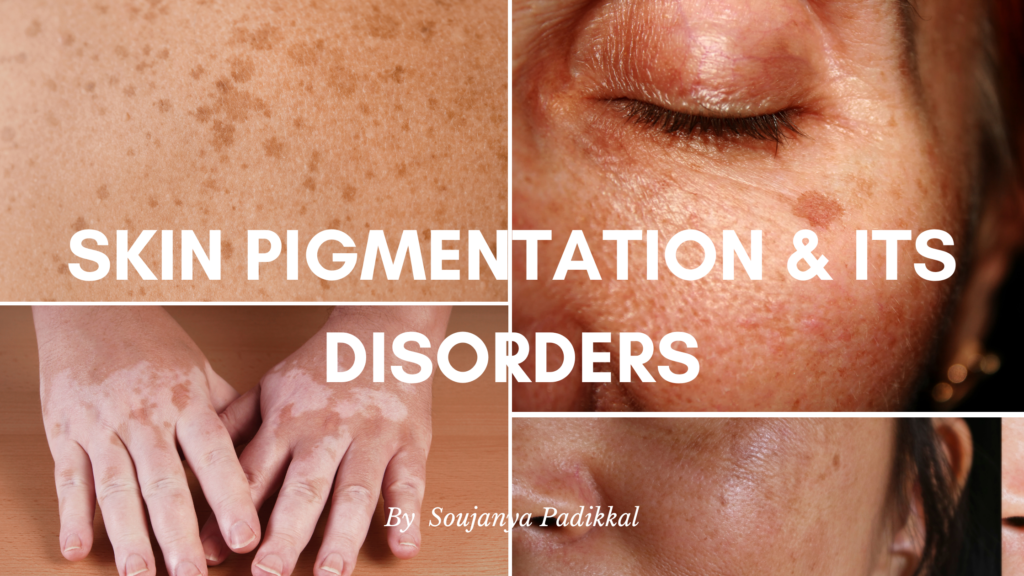Health & Wellness
SKIN PIGMENTATION & ITS DISORDERS
By Soujanya Padikkal
Birds display exotic colors. Sea animals enjoy a colorful life. Mammals exhibit a range of colors from black to grey to brown to white and all possible shades in between. And so do humans. But across this range of diverse colors also exists pigmentary disorders that messes up the uniformity of skin color. Before we dive into the disorders let’s understand the science behind skin color.
Skin pigmentation
Pigmentation refers to the coloring of the skin. The skin is our shield between the outside and inside world. It plays an important role in fighting infections. Epidermis, which is the topmost layer of the skin, is home to a group of cells called melanocytes that contain melanosomes which synthesize and store melanin (a pigment responsible not only for color, but also for protection of the skin from UV radiation). Skin color is determined by the type and amount of melanin produced within melanocyte.
Human skin has two types of melanin:
- Eumelanin – It is a dark pigment responsible for darker skin tones and also black hair.
- Pheomelanin – It is a light pigment responsible for lighter skin tones and shades of brown to red hair.
All of us have the same number of melanocytes but the amount of melanin produced varies. Apart from genes, the ratio of eumelanin to pheomelanin and the number of melanosomes in the melanocytes determines your skin, hair and eye color.

Image source: Melanomas of the skin and toes
Skin pigmentation disorders
Sometimes due to various reasons melanin production is affected in certain areas resulting in lower or increased melanin production than normal. This results in the development of various skin disorders. For ease of understanding I have divided pigmentation disorders into hyperpigmentation and hypopigmentation.

- Hyperpigmentation
According to National Cancer Institute hyperpigmentation is “a common, usually harmless condition in which patches of skin are darker than the surrounding skin.” It may be caused due to sun damage, inflammation of skin, hormone changes or as a side effect of medication resulting in freckles, spots, uneven darkened patches on the skin etc. Two most common examples of hyperpigmentation are melasma and post inflammatory hyperpigmentation (PIH).
a) Melasma
- It is a skin condition that causes patches or spots darker than one’s natural skin tone. It appears as brown, gray-brown, blue-gray, tan or freckle like spots. The discoloration usually occurs on the face like forehead, cheeks or upper lip, though, it can occur elsewhere on the body too. It occurs in both men and women.
- Radiation and hormones are the two main causes of melasma. In the skin of people with melasma, melanocytes become hyperactive (rate at which melanin is formed is high), producing more melanin causing uneven skin patches.
- It is also most commonly seen in pregnant women and hence is also known as “mask of pregnancy.” Oral contraceptives is another factor causing melasma. It fades post-partum or once you stop taking the pills.
- People with thyroid and Addison’s disease have a greater risk of acquiring it.
- Melasma is harmless and usually goes away on its own but it is a chronic condition and can affect the person’s self-esteem and emotional well-being as it alters our appearance.
- There is no single treatment or cure for melasma. The protocol and duration of the treatment depends on its exact cause and varies from person to person. It can be tricky as it can relapse (come back).
b) Post inflammatory hyperpigmentation (PIH)
- PIH results from over production of melanin following an inflammation or injury like burns, psoriasis or eczema, acne, bug bites etc. As a result, this skin condition shows up as tan, brown, dark brown, or even blue-gray patches and spots on your skin. PIH can effect either your epidermis (skin’s surface level) or dermis (deep layer of the skin).
- PIH is harmless and usually goes away on its own as new skin cells replace the old ones. But people with blemishes on the face may find it difficult to cope due to aesthetics reasons.
2. Hypopigmentation
Hypopigmentationis a condition in which patches of skin are lighter than the surrounding skin. It occurs when melanocytes are unable to produce the desired amount of melanin. Genes, environmental factors like UV rays or an infection contribute to hypopigmentation.
a) Albinism
- It is a rare inherited genetic disorder where the person is born with very light skin, hair and eye color
- Based on the genes involved, the type of albinism varies. In some there is a defect in the enzyme i.e. tyrosinase which is responsible for melanin production while in others a protein is involved.
- People with albinism have vision problems and it varies with the type of albinism.
- Because of low melanin production, they need to avoid sun damage and protect themselves. And hence are advised to always step out applying sunscreen.
- This disorder has no cure. Treatment involves monitoring vision and the skin for abnormalities. Annual checkups are recommended.
b) Vitiligo
- It is an autoimmune skin disease resulting in spots or patches of lighter skin.
- The body’s immune system attacks melanocytes affecting melanin production. Depending on the body part loss of color can be seen as:
- Lighter skin patches and spots
- Premature greying of hair
- Hearing problems (inner ear has melanocytes)
- Eyelashes turning white.
- It is not necessarily hereditary. It often runs in families but that alone doesn’t determine if a person would get it.
- In Ayurveda, the treatment aims to treat the cause of vitiligo and strengthen the immunity system.
As is obvious from the above, skin pigmentation disorders are caused by issues largely internal to the body. It is important though, to understand that discoloration of any kind is usually harmless and our need for a cure may more often than not stem from social stigma associated around beauty and appearance. The right approach would be to identify the cause and treat it with suitable medication and diet control. However, unfortunately, irrespective of the skin issue, we immediately start looking out for over the counter available cosmetic kit or topical creams that promise (falsely) a cure.
Hopefully now, you would stay away from buying over the counter anti-pigmentation soap or cream because you know you are simply buying a product packed in bunch of false promises.

